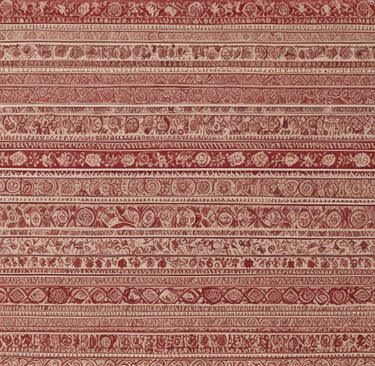The legacy of textiles in India can be traced back thousands of years ago, in the times when the Harappan civilization flourished in the Indus Valley. The very popular bust of the Priest-King where a male figure is portrayed donning a robe on his left shoulder with drilled trefoil pattern is an excellent indicator of the well-developed textile craft in the region. Evidence of cotton fiber, tools used in the process of weaving, excavated structures recognized as possible dyeing workshops, remains of indigo seeds and a solitary fragment of madder dyed cotton are all the proofs of an advanced textile manufacturing knowledge prevalent among the Harappans. One such textile tradition, known as Hand Block printing, possibly (although not conclusively proven) found its roots in this very civilization. Hand block printing or block printing is a technique where wooden blocks are pressed and stamped on the fabric to get desired prints. However, to obtain such finesse, an elaborate procedure is followed, which entails carving the wooden blocks, mixing the dyes, dyeing the fabrics, and stamping the designs. It requires great skills and artistic inclinations to produce a beautifully crafted block printed fabric.
The first preserved block printed fabrics of Indian origin were found at the excavations at Al Fustat, an archaeological site in Egypt, long after the Harappans were gone. The site is located on the Nile Delta, at the southern edge of Cairo. The dry climate of the region led to excellent preservation of the fabrics, hence making identification and provenance possible. Most of these are cloth fragments dyed either in madder or indigo colours with block printing in geometric motifs with white resist. Within India, the origin of the Al Fustat textiles has been traced back to Gujarat by the researchers. The motifs found on them are similar to patterns used in Islamic architecture of Gujarat as well as in Jain manuscript paintings. The fabrics are dated from 8th c. CE onwards up to 15th c. CE. Present day, these can be found housed across various museums around the world such as the Ashmolean at Oxford, Calico Museum in Ahmedabad, Textile Museum at Washington D.C., to name a few.
Also used as a technique to print texts and images, hand block printing is thought to have originated in China more than 2000 years ago. Prints on cloth have been dated earlier than 220 CE in region. However, the most concrete evidence is found in the form of the Buddhist text titled ‘Diamond Sutra’ produced during the Tang Dynasty. This text is 14 feet long and was created by the technique of wood block printing. It is a vital piece of evidence because it includes a production date of 868 CE. Woodblock print is also found in Japan and Korea from 8th c. CE onwards. It is from Asia that the technique found its way to other regions such as Europe and North Africa. In India, this art form was majorly used for textile production, to be exported to a vast region encompassing East Africa to Indonesia.
The blocks used for printing are made from teak wood or sagwan, pear wood, sheesham or rose wood and sycamore wood. There are usually two to three types of blocks involved in the process. The first type is called Rekh, meaning line, which is used to outline the pattern of the motifs or design. The second type is the Datta or Datlo and the Kaatmavi which are used to fill in the colour and the third type is the Gadh or Gad which is used for the background colour. Broadly speaking there are three types of block printing. The first is Direct printing where the cloth to be printed upon is bleached and then subsequently dyed and printed with wooden carved blocks. First the rekh blocks are used to make an outline and datta blocks are used for filling the colours. The second type is called Resist printing. In this type, there are areas that are protected from the dye by using a mixture of clay and resin. After dyeing when the fabric is washed it causes the dye to spread even in the protected areas through cracks, allowing a certain amount of dye to spread in. This creates a rippled effect on which the block prints are then used to create designs. The third type is called Discharge printing. This process involves dyeing the fabric first, then using a chemical to remove the dye from certain areas. These areas are treated and re-coloured with different colours and the entire fabric is block printed.
The art of block printing still survives in many pockets around the country in the states of Rajasthan, Gujarat, Andhra Pradesh, Madhya Pradesh, Uttar Pradesh, and West Bengal. At each of these places, the textile art form finds itself known by a different name and there are variations in the techniques of manufacture and designs that often reflect the local character of the place. For more than five centuries, India has witnessed the incredible evolution and bloom of block printed textiles. The craft flourished under royal patronage from various regions. Artisans have passed and preserved this knowledge from generation to generation. Even in the times of fast fashion and machine manufactured fabrics, block printing stands out for the intensive craftsmanship that it represents through its art. I personally love handlooms and proudly own two varieties of sarees in block print, the first is a cotton Sanganeri with intricate floral prints and the second is an indigo Ajrakh sourced from Kutch, which I received as a present from dear friends.


